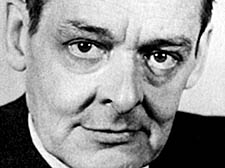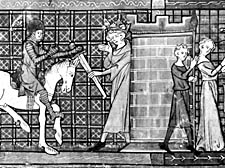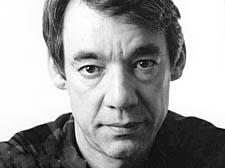|
|
 |
| |

TS
Eliot

A medieval Grail-lore image depicting the tale of Percival.
It is the first to mention a Holy Grail, per se, as the
object of a quest. One of the other unique elements of
the Percival story is the origin of the character of the
Fisher King. All were source material for The Waste Land

Roger Lloyd Pack |
Haunting verse which holds us spellbound
TS Eliot's ground-breaking poem
The Waste Land is as relevant today as when it was published
just after World War I, says Roger Lloyd Pack
POETRY brings you nearer and nearer to that crystal of light
of an untold number of facets reflecting everything. You can
feel the heat of it. And of course animals live right there!
We have fallen, but not that far! Poetry pulls us back where
we belong, brushing out the appearance of the world to leave
its essence”.
So writes Jehane West, the remarkable poet adventurer of the
Greek isles.
I first came across The Waste Land as an A’Level student
more than 40 years ago and, although a lot of it passed over
my head at the time, and some of it is still obscure to me even
now, it has haunted me for years.
So when poet John Rety asked me to read something to raise funds
to help pay the rent imposed by Camden Council on the Torriano
Meeting House, a valuable resource for established and potential
poets, I thought this might be an opportunity to have a look
at it once more.
It is hard to explain precisely the poem’s enduring influence
and its effect on a modern reader. It is certainly one of the
great pieces of 20th-century literature and continues to exercise
a hold over us today, even though a complete understanding of
it depends on a knowledge of Dante, ancient mythology, Christian
and Hindu religion, English, German and French literature, and
various other esoteric references that pop up every now and
again.
The bulk of the poem is, of course, accessible in its many different
aspects, particularly its images of London. For instance the
seedy sexual encounters in drab bedsits:
‘The meal is ended, she is bored and tired,
Endeavours to engage her in caresses
Which still are unreproved, if undesired...’
And the use of song and comic, colloquial and almost music-hall
passages in which he invokes the voices of Londoners.
But even in its more obscure passages it seems to exercise a
kind of visceral influence, so that even if one doesn’t
fully understand the precise meaning of the words, the images
they convey nevertheless resonate in a way that takes the listener
into another realm of being.
For years I have been obsessed with the opening line ‘April
is the cruellest month breeding lilacs out of the dead land’,
understanding some truth of it, and yet not understanding it
either, because April is a month of hope and promise. But after
reading Jessie Weston’s ‘From Ritual to Romance’
(source material for much of ‘The Waste Land’) it
occurred to me that to people who are depressed, people who
are living in a waste land, it would be a cruel month precisely
because of the suggestion of fruitfulness to come.
The grey, cold skies of winter are easier to cope with, in that
they reflect the people’s mood.
The Waste Land for Eliot, seems to be a land barren of spirituality
and love, and this land is represented for him, it would appear,
by western Europe.
It is an aspect of the poem that makes it particularly relevant
for today, when we are engaged in a global conflict between
two great religions.
The other main themes of the poem, connected to this, also seem
to have a particular relevance for us today, living in the beginning
of the 21st century, when we are threatened with an absence
of rainwater, and flooding from the sea.
The Waste Land is shot through with images of water, and the
lack of it, water to slake your thirst with and water to drown
in:
“Here is no water but only rock
Rock and no water and the sandy road.....
If there were water
And no rock
If there were rock and also water
And water
A spring
A pool among the rock...
But there is no water”
Eliot draws on ancient pre-Christian fertility rites to illustrate
the poem. The theme of water is tied up with the myth of the
Fisher King and the Holy Grail, another subject that seems to
be popular at the moment, with The Da Vinci Code, and now a
new prize-winning book by author Kate Mosse on the subject.
When the Fisher King, the leader of his country, is maimed and
wounded, then the country disintegrates and becomes barren.
The Fisher King is unable to procreate, and no children will
be born and nothing will grow on the land until he dies and
is either reborn or replaced by the questing knight who is searching
for the Holy Grail.
You could say that we now live in a world whose leaders are
wounded and inept and that the land will not recover until they
can be replaced by others who are prepared to act in its defence.
The Waste Land, published in 1922, is a landmark
in English literature. It was one of first Modernist works
to gain widespread critical acclaim and changed the direction
of poetry – although it initially divided critics.
It is renowned for its difficulty, obscure sources –
which range from ancient religions and myths to music
hall – and ‘sampling’ of other texts such
as Shakespeare.
Written shortly after World War I it is often interpreted
as a comment on the spiritual and cultural emptiness of
20th-century life. Its many fans find it a haunting and
elegaic masterpiece. |
|
|
 |
|



